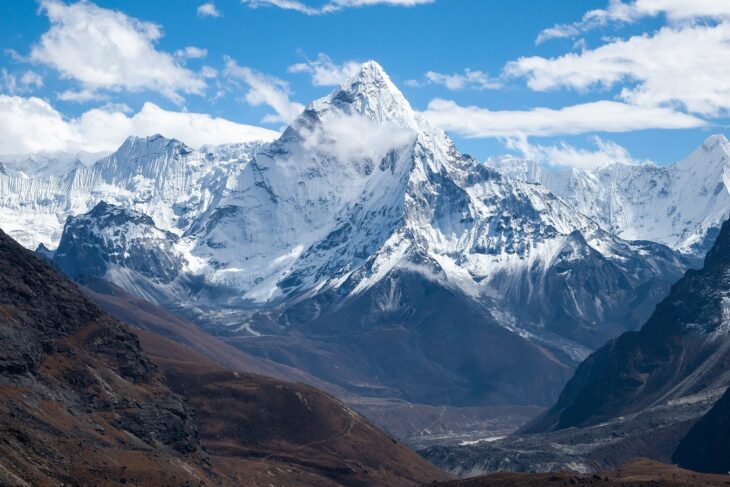Earth’s climate has varied dramatically over time. Places that were humid swamps 100 million years ago, during the age of the dinosaurs, were covered by glaciers 25,000 years ago, during the last ice age. Researchers have shown that many natural processes, like weathering of rocks and volcanic eruptions, add or remove greenhouse gasses like carbon dioxide (or CO2) from the atmosphere. Over thousands to millions of years, these processes alter the global climate. However, researchers don’t know how important each of these processes are in shaping the climate over long timescales.
Recently, scientists at the Chinese Academy of Sciences tested how weathering of the Tibetan Plateau influences global climate. The Tibetan Plateau, home to the tallest mountains in the world, is rapidly eroding as wind, rain, and glaciers eat away at the tall peaks of exposed rock.
Just like metal rusts when left outside, rocks break down when exposed to rain and air, through a process known as chemical weathering. Some types of chemical weathering add CO2 to the atmosphere, which causes the climate to warm. Other types of chemical weathering remove CO2 from the atmosphere, which causes it to cool.
Scientists have shown one chemical weathering process that removes CO2 from the atmosphere happens when CO2 naturally dissolves in rainwater, forming an acid called carbonic acid. Carbonic acid can dissolve certain types of minerals, including a class of minerals that contain silicon dioxide, known as silicates.
Silicates make up granite and many other rocks found in mountain ranges. When these minerals are dissolved by carbonic acid, the reaction removes CO2 from the atmosphere. Since rocks in mountains are made up of silicates and silicate weathering removes CO2 from the atmosphere, scientists have hypothesized that mountains help cool the climate.
However, researchers have also shown a different, less studied chemical weathering reaction can actually release CO2 into the atmosphere. This reaction occurs when oxygen in the air reacts with minerals containing sulfur, producing a different type of acid called sulfuric acid. Sulfuric acid dissolves a class of minerals found in limestone, known as carbonates. When carbonates dissolve they release CO2, which warms the climate.
The team of researchers from China specifically wanted to determine how important sulfuric acid chemical weathering is in the Tibetan Plateau. They collected water samples from streams, glaciers, springs, and rain at 44 different sites around the area.
When the sulfuric acid and carbonic acid chemical weathering reactions occur, they leave behind different dissolved elements in the water, like sulfur and chlorine, respectively. Researchers use the ratios of these elements in the waters like fingerprints that can be matched up to the specific reactions that formed them. By measuring the ratios of dissolved elements in the water samples, the scientists calculated how much CO2 each site had consumed or released by interacting with carbonic versus sulfuric acid. They compiled these results to estimate the total amount of CO2 consumed and released by the Tibetan Plateau.
The researchers found more than 80% of the CO2 consumed by the Tibetan Plateau during carbonic acid weathering was canceled out by CO2 released back to the atmosphere during sulfuric acid weathering. They suggested this meant the chemical weathering occurring at the Tibetan Plateau is much less effective at removing CO2 from the atmosphere than previous researchers thought.
They also discovered sites containing glaciers produce approximately 5 times more sulfuric acid than sites without glaciers. They explained glaciers are particularly good at grinding up rocks and exposing them to the air, where minerals containing sulfur can react to produce this acid. The scientists hypothesized that because sites with glaciers produce more sulfuric acid, regions around the world with glaciers release more CO2 through chemical weathering than regions without glaciers.
The researchers found the type of rock present at each site also influenced the amount of CO2 consumed and released. Sites containing lots of rocks with carbonate minerals, like limestone, released approximately 3 times more CO2 than sites containing lots of rocks with silicate minerals, like granite.
The researchers demonstrated that chemical weathering processes in the Tibetan Plateau release almost as much CO2 as they consume, but how does this stack up on the global scale? The authors estimated that 4% of all CO2 removed from the atmosphere by mountains worldwide is canceled out by sulfuric acid weathering in the Tibetan Plateau alone. They concluded sulfuric acid weathering in mountains influences long-term global climate change more than previous researchers realized.


